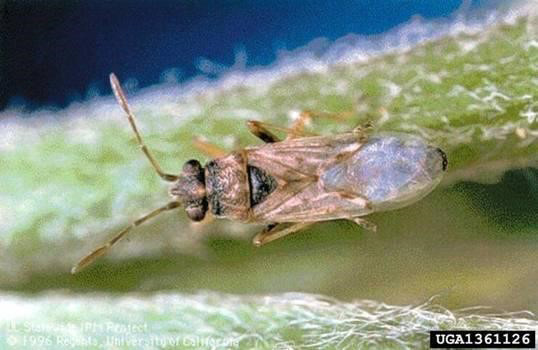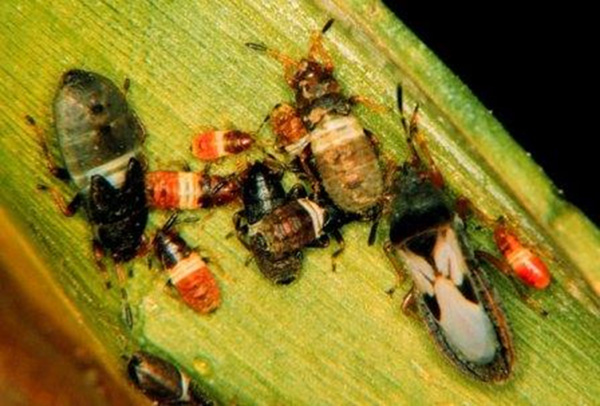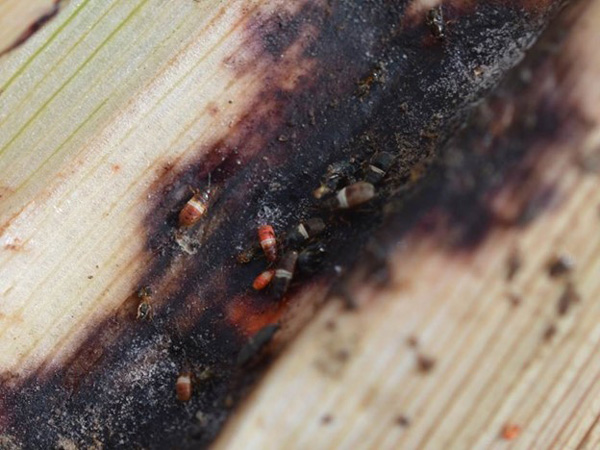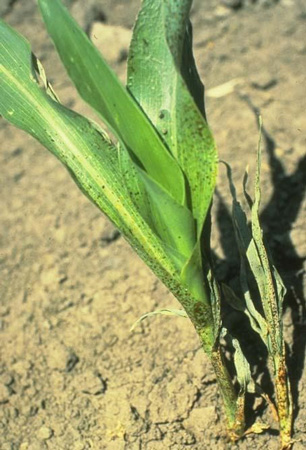Chinch bug activity has been elevated in Kansas over the last couple of seasons. Now would be a good time to discuss the differences between chinch bugs (Blissus leucopterus) and false chinch bugs (Nysius sp.). To make proper management decisions, knowing how to correctly identify these insects is critical.
Adults bugs
Adult chinch bugs are 3-4mm long bugs with black bodies and white wings that are kept folded over their backs. Two dark, triangular markings are present near the center of the wings, creating a distinctive “X” mark (Figure 1).
Adult false chinch bugs are very similar in appearance, but smaller. Instead of having black bodies, false chinch bugs are brownish-gray with clear wings that lack a distinct “X” mark (Figure 2).

Figure 1. Adult chinch bug. Photo by K-State Entomology.

Figure 2. Adult false chinch bug. Note the lack of a dark “X”.
Immature bugs
Immature chinch bugs are bright red after hatching, darkening to black as they go through a series of 5 molts. A distinct white band will be visible across the nymphs’ bodies until the wing buds become large enough to obscure it (Figure 3).

Figure 3. Immature chinch bugs. Photo by K-State Entomology.
Immature false chinch bugs are grayish-brown, never bright red, and lack the white band across their bodies (Figure 4).

Figure 4. Immature false chinch bugs. Photo by K-State Entomology.
Damage by bugs
Chinch bugs and false chinch bugs are true bugs in the order Hemiptera, which means they both have piercing-sucking mouthparts that they use to puncture plant tissue to feed on plant juices. However, the symptoms of feeding appear differently for these two bugs. When chinch bugs feed, digestive enzymes are injected into the plant tissue, causing it to break down and discolor (Figure 5). Reddish spots are often present at chinch bug feeding sites. Heavy chinch bug feeding can also cause stunting, wilting, and necrotic lesions on plants. False chinch bug feeding, on the other hand, usually has little effect on plants, but extreme numbers of the bugs on a plant can cause wilting and death (Figure 6).

Figure 5. Discoloration caused by chinch bug feeding. Photo Jeff Whitworth, K-State Research and Extension.

Figure 6. False chinch bug feeding damage to sorghum. Photo by K-State Entomology.
Be proactive about chinch bug management
Think about chinch bug management before wheat is harvested. Simply relying on rescue treatments for young sorghum fields is not recommended. If possible, avoid planting sorghum adjacent to wheat, particularly if the wheat stand is thin and stressed out. Wheat fields should be scouted for the presence of chinch bugs before harvest to provide an estimate of risk to newly planted sorghum fields. One adult chinch bug or 5 nymphs per foot of row will be a hazard to the borders of sorghum planted nearby. If chinch bug problems are expected, an early planted trap crop of sorghum can be utilized between the wheat and sorghum fields, and this trap crop can be sprayed if migrating chinch bugs become numerous. Follow-up sprays will likely be needed if the local chinch bug population is high; 5 chinch bugs per seedling would warrant action. Planting time insecticides and seed treatments can provide some early protection for young sorghum, but their effectiveness deteriorates beyond a few weeks. Additionally, scouting should be done weekly during the growing season. Plants that are a foot tall and all the way through flowering can be damaged by 50 chinch bugs per plant.
Additional details on life history and management recommendations for these two pests can be found in the following Kansas Crop Pest publications.
- Chinch Bug: https://bookstore.ksre.ksu.edu/pubs/MF3107.pdf
- False Chinch bug: https://bookstore.ksre.ksu.edu/pubs/MF3047.pdf